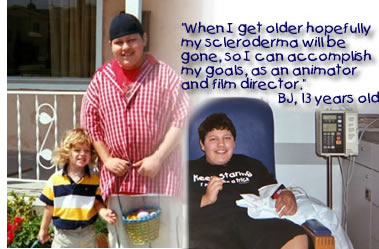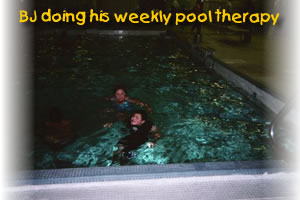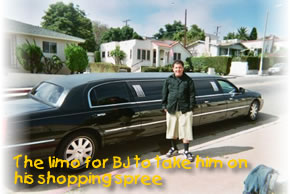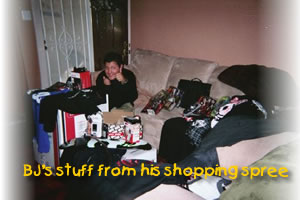|
BJ's Story: Growing up with Juvenile Scleroderma
My son, BJ, was not any different from any toddler until one day in pre-school the teacher reported to me that BJ was having difficulty cutting with scissors and with finger painting. I started to notice shortly after that he wasn't as active as other children, and he was not able to use his hands like other children.
By this time BJ's right fingers were becoming a bit crooked. His pediatrician suspected it could possibly be arthritis. I thought to myself he really never complained of joint pain. Although, we do have strong family history of arthritis, but not in children. How could this be possible? His pediatrician sent us to see a pediatric rheumatologist.
December 1995, the nightmare began for weeks trying to find out what was wrong with BJ. The pediatric rheumatologist ordered a number of blood tests every two weeks. BJ was so terrified of needles it took myself and my mom to hold him down. BJ would try to bite and fight us to get away. It broke my heart to see him this way.
 After the first blood test came back the pediatric rheumatologist wasn't sure what he had. He mentioned to me that BJ could have Juvenile Rheumatoid Arthritis (JRA), Lupus or Eosinophilic Leukemia. When I heard the word Leukemia I thought my son was going to die. I did not know what Lupus was at the time. And generally, when you think arthritis, you think elderly people get this, and not children. I had to wait a month to find out what my son had because the hospital lab kept losing his blood tests. After the first blood test came back the pediatric rheumatologist wasn't sure what he had. He mentioned to me that BJ could have Juvenile Rheumatoid Arthritis (JRA), Lupus or Eosinophilic Leukemia. When I heard the word Leukemia I thought my son was going to die. I did not know what Lupus was at the time. And generally, when you think arthritis, you think elderly people get this, and not children. I had to wait a month to find out what my son had because the hospital lab kept losing his blood tests.
Finally the nerve wrecking day was here to find out what is wrong with my son. At the age of 4 years and 10 months he was diagnosed with JRA. The pediatric rheumatologist said to me if BJ doesn't take his medication and get physical therapy (PT) and occupational therapy (OT) JRA can be a crippling disease if not treated aggressively.
At the beginning of his diagnoses he was taking a nonsteriodal anti-inflammatory drug (NSAID). This was to relieve some of his pain and stiffness. It appeared that after a months use of an NSAID, BJ was beginning to run a little bit stiff, and he had difficulty getting in and out of a car and his bed. There were times he would get out of bed and fall to the ground because he couldn't walk. BJ said his feet felt like they were twisted. I had to carry him to the bathroom or from one room to another at times.
I had taken BJ back to the pediatric rheumatologist because I was not satisfied with his treatment for JRA. The pediatric rheumatologist put BJ on corticosteriods for about two weeks. Within the two weeks BJ had improved quite a bit. He could get in and out of the car and his bed with no problem.
June 1996, BJ's JRA had turned for the worst. BJ couldn't sit on the floor like the other children in his pre-school class. He couldn't play a lot of the outside activities with the other kids. BJ missed a lot of school from feeling fatigue and from his legs hurting. BJ was starting to have problems dressing his self, brushing his teeth and hair. He started sleeping more frequently. Finally I decided to take him to a different pediatric rheumatologist for treatment. The new pediatric rheumatologist agreed BJ had JRA. He decided to increase BJ's medications to NSAID and an disease-modifying anti-rheumatic drug (DMARD).
After two months of his treatment BJ had showed no improvement. On the right side of his arm he developed a light and dark pigmentation on his skin. The pediatric rheumatologist thought this could be vitiligo. On the right side of BJ's hair line he start to lose hair.
I remember clearly the day I was sitting in the hospital clinic, BJ was seeing the PT after his rheumatology appointment. The PT noticed BJ was starting to lose his foot prints, and the right foot was an centimeter shorter than his left foot. Because BJ was so stiff and his skin was becoming tight the PT and his pediatric rheumatologist decided to admit him to the rehabilitation unit at the hospital. I didn't want my son to see me get upset. I tried so hard to keep the tears back, but I just couldn't control it any longer. I burst out in tears. The worst thing in the world is for your child to see you cry. So my son started crying, too. I had to explain to him why I was crying. The pediatric rheumatology nurse gave us a tour of the rehabilitation unit. I was told BJ had to stay there for six weeks for PT and OT everyday.
August 1996, days before BJ was to be admitted, he had developed a brown, shiny spot on his stomach. I thought what is going on now. I called up his pediatric rheumatologist to explain this. He said since BJ would be coming to the hospital in a couple of days he would look at it. Those couple of days seemed to take forever. Once, BJ was admitted, his pediatric rheumatologist came in to see him. He looked at BJ's stomach. He didn't say much because he didn't want me to know what he thought BJ might have. He knew I was the type of mom who does research if I don't know something. He ordered new blood tests. So once again, I had to sit and wait to see what else was wrong with BJ.
A couple of days later the blood tests came back. The pediatric rheumatologist said to me BJ has Scleroderma (SD). I thought to myself SCLERO-WHAT!! They gave me one pamplet to read about this disease. It was mentioned to me there isn't much information about SD because it is a rare disease and especially in children. Everythig I read was a death sentence.
I had learned generally when you read about SD it is basically mentioned as a minor lesion to a debilitating and fatal disease. Scleroderma means hard skin and is pronounced skler-o-derma. There are two types of SD: (1) Localized - which affects the skin, subcutanious tissue and occasionally muscle and bone. (2) Systemic - which strikes the esophagus and internal organs as well as the skin and can be life threatening.
BJ was diagnosed with Linear SD a form of Localized SD. This is an area of thickened and tight skin that develops in a "line" down an arm or leg. As mentioned before BJ's right leg is shorter than his left leg because Linear SD can interfere with growth of the limb. The vitiligo was the Linear SD, and the loss of hair was also due to the SD. It had been mentioned when your hair falls out it does not grow back.
After all this time we thought BJ had JRA when he actually had Juvenile Scleroderma (JSD). It's not uncommon for SD to be misdiagnosed for RA or Lupus.
It broke my heart to know there isn't a cure or research being done on JSD. Since SD is basically treated with the same medications as arthritis or other rheumatic diseases, BJ's pediatric rheumatologist decided to keep him on the same DMARD, Methotrexate. This was in hope to slow down the progression.
August 1997, I decided I wasn't going to let the disease run us, we were going to run the disease. I was not going to let this destroy me or my son. I started educating myself more on JSD and about educational rights for children. BJ and I started educating the school teachers and child development students about JSD, and BJ's bad experiences in school.
August 1999, I realized after two years there wasn't enough support for us parents of a child with JSD. I found most SD organizations may use children to promote their organization, but they do not focus on JSD support or programs. There issues and help are for adults suffering with SD. I decided that I was going to turn my and BJ's negative experience with JSD into something positive for us and for other families. This is when I founded the Juvenile Scleroderma Network (JSDN). I run this organization out of my home. We provide educational and emotional support to children and their families and to enhance public awareness.
I have found the best therapy dealing with your own child's chronic illness is to participate in a support group of similar issues regarding children. And if there's not a support group in your area, don't be afraid to start a support group yourself! People working together can make a difference in their special cause!
Of course BJ at times gets really upset that he can't do what other kids his age can do. He finally realizes when people stare at him its only because they are curious. He doesn't have a problem talking about the JSD to other people.
When BJ grows up he wants to be a NASCAR driver and race against Jeff Gordon #24, and he wants to be a cartoonist. He tries not to let the JSD get in his way of drawing, since how he is right handed and the JSD is in the right hand too.
BJ is my inspiration, because I admire how he tries to live a life without limitations and frustrations dealing with a disease everyday. It takes a lot of courage to get up every morning to see what challenges will come his way. I think sometimes BJ handles having JSD better than I do.
I truly believe that God brought JSD into our lives for a reason. A reason to help other families of children with JSD. Until there is a cure for JSD, and beyond that cure I will always be here to help others learn from BJ.
Having a child with a chronic illness does not have to be a negative experience, turn it into a positive mission!
January 2000, BJ had hand surgery to help correct the contractures causing deformity in his right wrist and arm. The orthopaedic surgeon, lengthen his muscles and ligaments in his arm that had contracted around his bone. He had a small skin graft added to his wrist. At the time there was no guarantee how will the benefits be from the surgery.
As of today BJ is ten years old. His JSD continues to progress all through his right side of his body, lesions on his chest, stomach and some on his left side of his arm. He takes Methotrexate by injections once a week. He continues to see his pediatric rheumatologist once a month to monitor the progression, and he has blood test taken on every visit to make sure the medication isn't doing any harm to his body. He has just started seeing an OT two times a week. He has to see a psychotherapist for psychosocial stresses and coping relating to the JSD.
 March 2004: BJ still as of today continues to progress. For awhile last year his skin started to soften up. Now all the softeness has gone away. We have made a new change in BJ's schooling. In March I decided to start homeschooling him. This was the best decision I have ever made. Now we can focus just on his scleroderma without the constant stress from the school. The kids were getting really bad with the teasing. BJ stays more focused on his homeschooling work and now he is opening up to me about his scleroderma. He tells me what he wants to do to make his scleroderma better. I feel we still have a long ways to go, but I'm confident that we will make it through this together. March 2004: BJ still as of today continues to progress. For awhile last year his skin started to soften up. Now all the softeness has gone away. We have made a new change in BJ's schooling. In March I decided to start homeschooling him. This was the best decision I have ever made. Now we can focus just on his scleroderma without the constant stress from the school. The kids were getting really bad with the teasing. BJ stays more focused on his homeschooling work and now he is opening up to me about his scleroderma. He tells me what he wants to do to make his scleroderma better. I feel we still have a long ways to go, but I'm confident that we will make it through this together.
October 2005: It is often when we have a child with JSD they can experience some kind of depression. Some are mild depression, and some are so severe it could lead to
suicide. Never let any type of depression slip by you even if you are not sure
if your child is suffering from depression. Talk to you child's pediatric
rheumatologist, pediatrician, and if possible contact a child psychologist. If
your child needs medication for his/her depression don't forget to let your
child's pediatric rheumatologist know right away.
I cannot express enough how important this is because I'm living it with my son,
BJ. BJ has suffered depression for years. I've tried a couple of times to find
him a 'good' counselor. This is also important, if the child and counselor do
not connect the child won't open up and it will almost be impossible for the
child to get help from that counselor.
What I didn't know about BJ's behavior problems years ago til current was this
was part of his depression. I had always thought my child was a troubled child
and just acted out. Little did I know. The mood swings were horrible.
From July to November 2004 BJ was put on Solumedrol for his JSD. During that time, til current his mood swings became out of control. His anger was like a monster coming out of him. He hated me, he hated himself. He wished I was dead, and he wished he
was dead. He thought of ways to kill me, and he thought of ways to kill
himself.
Sunday, March 27, 2005 our lives have now completely changed for the worst! He
went into a full blown out of control rage out of nowhere. This rage landed him
in a mental health hospital the next day. He went voluntarily with me because
he wants the help to get better. BJ did very well in the hospital. He had to stay there for two weeks. While he was in the hospital his psychiatrist diagnosed him with bipolar disorder (BPD). So from what I thought was just a severe depression has now been diagnosed into BPD. BJ has made comments to me saying he fells like his body his falling apart because he has so many different things wrong with him. This is just another illness we will have to work through.
So, please if you think or if your child is suffering from any type of
depression get help now!
Shortly after BJ was released from the hospital we immediately found him a licensed clinical social worker and a psychiatrist. Giving BJ’s medication history of Solumedrol, and how his behavior/depression had been even being off the Solumedrol to his psychiatrist he knew right away BJ’s BPD was drug-induced by the Solumedrol.
We have also made changes in how he is being schooled. BJ wanted to go back to a public school, but I didn’t want him to go back to a public school. So, we met each other half way…he’s now in a charter School. He goes to school twice a week for a couple of hours each time. I thought homeschooling was great, having him in a charter school is better! His medical appointments and school time do not clash. We work around his school time so he doesn’t miss any school. He has a wonderful teacher!
At BJ’s last pediatric rheumatology appointment, August 2005, his pediatric rheumatologist agreed with me and BJ that his JSD had seemed to soften up once again, and some of his lesions are fading away. We hope this continues to stay positive! At this time he currently is on no medications for his JSD. We will take one pediatric rheumatology visit at a time to see what happens.
BJ is back in with OT/PT. His occupational therapist will probably make him a wrist splint. She is checking into silver ring splints for his two fingers on his right hand. His PT he is having a blast. They are doing pool therapy instead of land therapy. He sees his occupational therapist and physical therapist weekly for an hour. He still wears his orthotics and we are in the process of getting a shoe lift added onto his right shoe.
 Just recently, August 2005, BJ had the opportunity to make a wish with the Make-a-Wish Foundation. His wish was granted to go on a $2500.00 shopping spree! The foundation sent over a limo to pick us up, and take us to the mall of his choice. He chose Southbay Galleria because he knew for sure his favorite store, Hot Topic, was there. He got to go to lunch of his choice. So, while we were at the Galleria BJ wanted to eat at the Red Robin, another favorite of his. He shopped til he dropped. He came home with so much stuff from clothes to a computer. That boy knows how to shop! Just recently, August 2005, BJ had the opportunity to make a wish with the Make-a-Wish Foundation. His wish was granted to go on a $2500.00 shopping spree! The foundation sent over a limo to pick us up, and take us to the mall of his choice. He chose Southbay Galleria because he knew for sure his favorite store, Hot Topic, was there. He got to go to lunch of his choice. So, while we were at the Galleria BJ wanted to eat at the Red Robin, another favorite of his. He shopped til he dropped. He came home with so much stuff from clothes to a computer. That boy knows how to shop!
 BJ has been very busy with joining a film club at the Boys and Girls Club of San Pedro, and learning to play the drums there as well. Now that he’s become a teenager he has changed his mind from becoming a NASCAR driver to a film director. I’m sure he will be a very successful film director, and I’m sure being a film director is a much safer career than a NASCAR driver. BJ has been very busy with joining a film club at the Boys and Girls Club of San Pedro, and learning to play the drums there as well. Now that he’s become a teenager he has changed his mind from becoming a NASCAR driver to a film director. I’m sure he will be a very successful film director, and I’m sure being a film director is a much safer career than a NASCAR driver.
We can only hope for the best, and see what 2006 brings to us. Stay positive!
For more information on Juvenile Scleroderma, contact:
Juvenile Scleroderma Network, Inc.
1204 W. 13th Street, San Pedro, CA 90731
Tel: (310)519-9511 (Pacific Time)
24 Hour Support Line: 1-866-338-5892 (toll-free)
Non-Medical Questions or Comments? Click Here
Medical Questions? The Doctor's In: Q & A 
|
